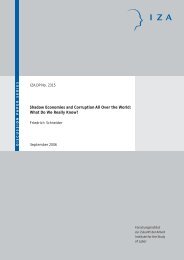Health Outcomes and Socio-Economic Status among ... - Index of - IZA
Health Outcomes and Socio-Economic Status among ... - Index of - IZA
Health Outcomes and Socio-Economic Status among ... - Index of - IZA
Create successful ePaper yourself
Turn your PDF publications into a flip-book with our unique Google optimized e-Paper software.
We use the average number <strong>of</strong> correctly immediate <strong>and</strong> delayed recalled words as our memory<br />
measure (see McArdle, Smith <strong>and</strong> Willis, 2009).<br />
Figure 7 displays the mean number <strong>of</strong> words recalled by men <strong>and</strong> women, by age. Word<br />
recall declines in a concave manner with age, with a steeper decline at older ages. Some <strong>of</strong> this<br />
shape may also be caused by schooling being negatively correlated with age; regressions will<br />
thus be important to retrieve multivariate correlations. Men are better able to recall than women,<br />
which could be a function in part, <strong>of</strong> having more education. Indeed, in Table 10 the SES<br />
coefficients are positively correlated with word recall <strong>and</strong> strongly significant in almost all cases.<br />
Age dummies are significantly negatively correlated with word recall. Education at the junior<br />
high or above level for men is associated with 1.5 more words recalled, for women the marginal<br />
effect is quite similar. PCE is also highly correlated with word recall, although the direction <strong>of</strong><br />
causality is much less clear. It is also the case for women that this correlation disappears when<br />
community fixed effects are added. The community dummies are jointly significant for both<br />
men <strong>and</strong> women. These results are consistent with the results <strong>of</strong> McArdle et al., 2009, for the<br />
HRS data where word recall is highly correlated with educational attainment.<br />
Survival expectations<br />
In CHARLS, as in the HRS, we ask respondents about the chances that they will live to a<br />
particular age. Respondents answer on a 5 point scale, from 1 which means almost no chance, to<br />
5 which means virtual certainty. We do not ask probabilities directly since our pretest<br />
experience, <strong>and</strong> experience in other low-income countries indicated a real difficulty for<br />
respondents to underst<strong>and</strong> probabilities. Experience with HRS <strong>and</strong> other aging surveys has<br />
shown that answers to this question are highly correlated with survival to subsequent waves (for<br />
example see Banks et al., 2009).<br />
23
















